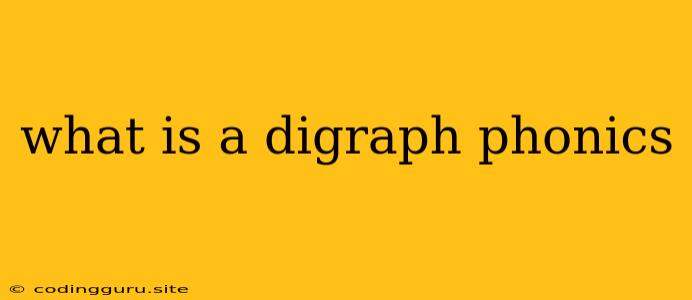What is a Digraph Phonics?
Learning to read can be a challenging journey for young learners, and digraph phonics plays a crucial role in making this journey smoother. But what exactly are digraphs, and how do they help children decipher the written word?
Digraphs are two letters that combine to represent a single sound. These combinations can be made up of two consonants, two vowels, or a combination of both. Understanding digraphs is essential for mastering phonics and becoming a confident reader.
Why are Digraphs Important?
The English language is notorious for its inconsistencies in spelling. While some letters are pronounced the same way consistently, others can have multiple sounds depending on the context. Digraphs help us navigate these complexities by providing a predictable representation of sounds.
Imagine trying to read a word like "ship" without knowing that "sh" represents a single sound. It becomes a confusing jumble of letters! However, once you understand that "sh" is a digraph, the word becomes clear and easy to pronounce.
Types of Digraphs
There are several types of digraphs, each with its own unique sound:
Consonant Digraphs
- "sh": As in "ship", "fish", "crash"
- "ch": As in "chair", "catch", "lunch"
- "th": As in "thin", "that", "other"
- "wh": As in "where", "what", "when"
- "ph": As in "phone", "graph", "elephant"
- "ck": As in "rock", "pick", "duck"
- "ng": As in "sing", "ring", "long"
Vowel Digraphs
- "ai": As in "rain", "train", "sail"
- "ay": As in "play", "day", "stay"
- "ee": As in "see", "tree", "bee"
- "ea": As in "sea", "read", "team"
- "ie": As in "lie", "tie", "pie"
- "oi": As in "coin", "noise", "join"
- "ou": As in "cloud", "house", "mouse"
- "ow": As in "cow", "town", "how"
Digraphs with a Vowel and Consonant
- "ph": As in "phone", "graph", "elephant"
- "wh": As in "where", "what", "when"
How to Teach Digraph Phonics
Teaching digraph phonics to young learners requires a combination of fun activities and consistent practice:
- Introduce digraphs gradually: Begin with a few common digraphs like "sh", "ch", and "th" and then gradually introduce more complex digraphs.
- Use visual aids: Create flashcards with pictures and words representing each digraph.
- Play games: Make learning fun with games like "Digraph Bingo", "Digraph Memory Match", or "Digraph Scavenger Hunt".
- Read aloud: Regularly read books that contain the digraphs being taught. Point out the digraphs and help children sound them out.
- Write words and sentences: Encourage children to write words and sentences using the digraphs they have learned.
Example: Teaching "Sh"
- Introduce "sh" with a picture of a "ship" and a "fish".
- Say the words slowly and clearly, emphasizing the "sh" sound.
- Show a flashcard with the "sh" digraph.
- Ask children to repeat the sound and identify other words with the "sh" sound.
- Play a game where children have to find pictures with the "sh" sound.
Conclusion
Digraph phonics is a crucial element in helping children decode words and become fluent readers. By understanding how these letter combinations represent single sounds, children can overcome the complexities of English spelling and unlock the joy of reading.
